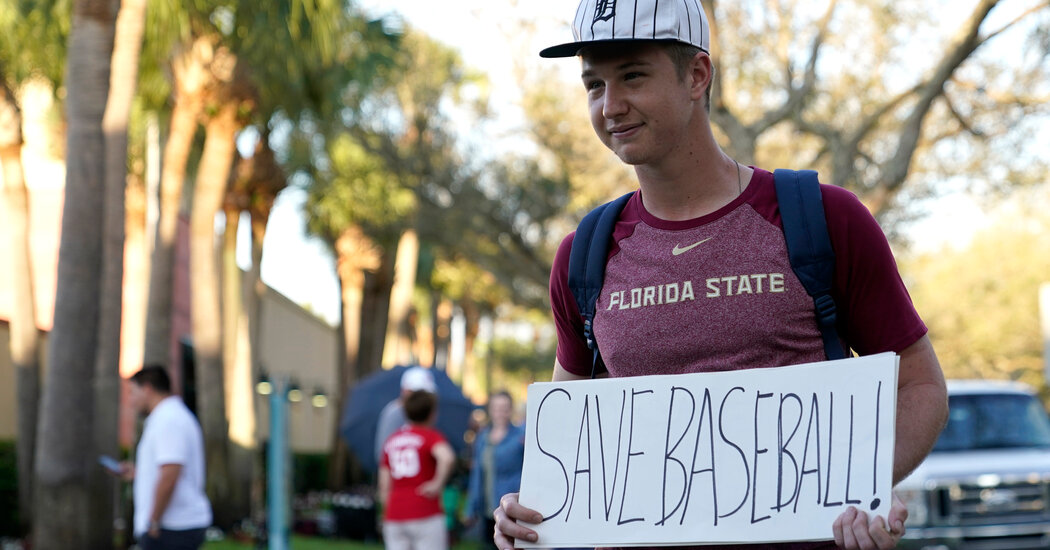
JUPITER, Fla. — After a marathon day of negotiations that ended at 2:30 a.m. on Tuesday, Major League Baseball extended its deadline to reach a new labor deal with the players’ union to start the 2022 regular-season on time. Instead of canceling games, as it had threatened, baseball set a new deadline: 5 p.m. Tuesday.
The reason: A league spokesman, who spoke to reporters on the condition that he not be named, said the sides had made progress and wanted to exhaust every possibility to reach an agreement. The talks are expected to resume at 11 a.m. on Tuesday. Reaching an agreement in the few hours before the new deadline, though, was not certain given the sizable gaps that remained on several major issues.
M.L.B., which locked out the players on Dec. 2, is scheduled to open the regular season on March 31. But after making little headway with the union during negotiations in Florida last week, the league doubled down on its position with a threat to begin canceling games beginning with a self-imposed Monday deadline.
If that deadline to reach a new collective bargaining agreement was not met, the league warned the players’ union, it would begin canceling games, not pay players for those missed games and not reschedule them.
The union rejected the deadline, but the 11th hour threat appeared to spur action. The sides negotiated for 16 1/2 hours on Monday — although most of the time was spent meeting privately and preparing proposals. But two top player representatives, the veteran pitchers Andrew Miller and Max Scherzer, and a top ownership representative, Dick Monfort of the Colorado Rockies, remained at the stadium into the early hours of Tuesday morning.
The day also featured a new dynamic: the top leaders for M.L.B. (Rob Manfred, the league’s commissioner, and Dan Halem, the league’s lead negotiator) and the union (Tony Clark, its executive director, and Bruce Meyer, its lead negotiator) met face to face twice.
The leaders of both organizations don’t normally meet to haggle, leaving that to their lead negotiators. But a union official, who spoke on condition of anonymity given the sensitive nature of the negotiations, said Manfred indicated during an afternoon meeting that he wanted to make a deal.
Asked if there was any progress after another evening meeting, Manfred said, “We’re working on it.”
The players have been without a contract for three months. When the sides could not reach a new five-year C.B.A. ahead of the expiration of the old one on Dec. 1, Manfred locked out the players the next day, bringing the sport to a standstill and halting all transactions and interactions with players. He said at the time that he was doing so to stimulate talks and protect the 2022 season.
When the sides remained entrenched in their positions in early February, Manfred said losing regular-season games would be “disastrous” for the industry. Weeks later, though, baseball issued its threat to begin canceling games.
While it has taken place — until now — entirely during the off-season, the current lockout qualifies as the second-longest work stoppage in baseball history. The longest was the 1994-95 players’ strike, which resulted in the loss of more than 900 games and the cancellation of the 1994 World Series.
The current labor negotiations were not expected to be easy. The past two collective bargaining agreements were viewed as having further tilted the balance of power and economics in the owners’ favor. Realizing that significant changes to the system would be tense and full of brinkmanship, the union has spent years building a rainy-day fund for this very fight against M.L.B. owners, who ran an $11 billion-a-year business before the coronavirus pandemic.
While top players have been awarded record contracts in recent years, including this off-season before the lockout, the players are frustrated that their average salary of roughly $4 million has reached a plateau and failed to keep pace with team revenues. In 2021, most players earned salaries of less than $1 million. And the average career length is about four years.
To address those averages, the union has sought a series of changes, including obtaining earlier compensation for younger players; improving competition among teams; curbing service time manipulation; and injecting more spending.
The league, though, believes the players have a fair system without a hard salary cap and sees the issue as a matter of wealth distribution: that star players are disproportionately commanding more money than others. While owners have offered ways to pay younger players more, they had also proposed some ways to generate more revenue to pay for it (such as expanding the playoffs or putting advertising patches on uniforms) and methods to curb overall spending elsewhere (such as their stricter luxury tax model).
As a counter to M.L.B.’s deadline threat, the players previously issued their own threat during these labor negotiations: They told the league they were reluctant to grant club owners an expanded playoffs — a change that could be worth an estimated $100 million annually — if games and money were taken from them.
M.L.B. originally chose Monday as a deadline because it believed a minimum spring training length of four weeks — two weeks shorter than normal — made sense to avoid a spike in injuries like the one before the pandemic-shortened, 60-game 2020 regular season. As it became clear — despite some progress and exchanges of proposals — a deal wasn’t close to being completed, M.L.B. told the union it was extending its deadline.
In the latest iteration of the proposal package, the sides had settled on the playoffs expanding to 12 of the 30 clubs from the current 10. M.L.B. had been seeking a 14-team postseason, a jump the players thought would water down competition and the value of the regular season.
Some of the big items that remained unresolved entering Tuesday were significant. The sides remained separated on the league minimum salary (the latest proposal package included an offer of $675,000, which was $100,000 more than in 2021 but $100,000 less than the union had been seeking); a bonus pool for top players not yet eligible for salary arbitration (a proposed $25 million, while the union had been seeking $115 million); and the luxury tax system (a proposed first threshold of $220 million and rising to $230 million, along with the less onerous tax rates of the previous C.B.A.).
Tuesday may bring more haggling and compromise — or not. In its early hours, though, all the sides had was a reprieve.




